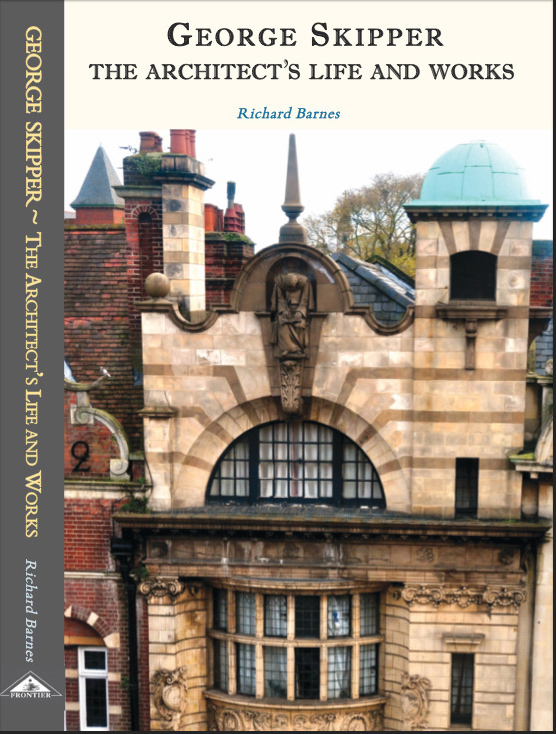George Skipper

George Skipper - The Architect's Life and Work
George Skipper (1856-1948) was born in Dereham in Norfolk, the son of a builder and developer who owned a brickyard. The boy excelled at drawing and attended Norwich Art School, studying art and an artisan's course on Architecture. He was then apprenticed to a London architect who worked under Alfred Waterhouse and other influential figures. Returning to Norfolk, Skipper assisted his father before starting his own practice in Norwich.
His pastimes, revealed in some of the forty-seven annual pocket-
sketchbooks in the RIBA collection, involved visiting old ruins, churches and
houses, where he would sketch and measure arches, cornices and corbels. This
was an art ritual. His ability to draw made a huge difference, often winning
competitions for commissions on the strength of a first drawing. This happened
in the early 1880s in Somerset where he designed hospitals, and terraces of
houses for Mr Clark, the shoe manufacturer. Another competition led to the
design of a hotel in Cromer, developing into a series of seaside hotels and houses.
The architect often used special bricks and terracotta details made by Mr
Gunton of Costessey, and employed some of the best artists and artisans of the
era, notably William Neatby of Doulton & Co, who brought brightly coloured
ceramics to the Royal Arcade.
Skipper, by then in partnership with his brother, a surveyor, was
phenomenally busy around the turn of the century. He designed and took full
responsibility for Surrey House, the mansion-office of Norwich Union Insurance.
He was aided by William Brindley, who roamed the world to obtain rare marble,
and Edward Potter of Norwich, who added electric power to his stonecutting
machinery. The rightness of the design of the Neo-classical building won the
admiration of architectural writers and critics. Commissions followed - a stock
exchange, a newspaper office, two banks, and another insurance headquarters
(the present-day St Giles Hotel) in rich Baroque style and likened to a mini-
Chatsworth. It was Skipper who put the corner curve on Jarrold's Department
Store, complementing the varied architecture of Norwich's famous Market Place.
Two commissions outside the city were the yacht club (RN&SYC) in Lowestoft in
an Arts and Crafts style, and the alteration of a grand country house and the
addition of its outworks - the lodges, stables, bell-tower, pavilion and bridge - at
Sennowe Park, near Fakenham.
Previously a widower, George married his wife Alice in 1913; the couple
had two children, an artistic daughter and a son who would be an architect. The
First World War all but took away his practice, though the 1920s saw him
designing a town for Welsh miners in the Kent coalfields, and providing plans for
social housing in Norwich. In contrast he worked for King George V at the
Sandringham estate on three occasions, and won a competition for a grand Neo-
classical street in London. The decade also saw Skipper and other architects and
historians oppose the plan of 1923 to demolish the ancient Bishops Bridge. In
doing so they founded The Norwich Society, guardian of the city's heritage.
In his eighth decade, the white-haired architect went back into the fray,
opening a London office near the big Sackville Street scheme. To his frustration,
the program was held up. Skipper returned to Norwich before the Second World
War began. Norwich endured a blitz in 1942. The elderly architect, in response
to warnings of fire risk, went to his old office to remove and destroy his large
plans and finished drawings of former years. He died after the war ended. A few
Skipper buildings were demolished in the 1970s before he was 'rediscovered' by
architectural writers like John Betjeman, Ian Nairn and Gavin Stamp. Norwich
Art School celebrated George Skipper in an exhibition in 1975, and it is from this
time that Skipper has been seen as more significant. He was an artist-architect
who combined facets of Art Nouveau, Neo-vernacular, Neo-classical, high
Baroque, and Arts and Crafts styles. Many of his works are now listed as
buildings of special architectural or historic interest.
The point that Betjeman, Nairn and Stamp made is that when people see
Skipper's creations, they realise that he has been neglected at a national level.
Readers and students in London may know of Lutyens, Baker, Blomfield, Baillie
Scott, Norman Shaw, Voysey, and Waterhouse - but not of Skipper: should he be
better known? Was he a provincial prodigy, or a significant English architect? It
is the intention of this book to show the breadth and quality of Skipper's work,
and to allow readers and viewers to answer this question.
George Skipper - The Architect's Life and Works provides all that is
known of the man, with information from his family, and descriptions of his
works in Somerset, Kent, Cambridge, London and Norfolk. Sources include the
Royal Institute of British Architects and the Norfolk Record Office. The book is a
middle-size format hardback with plenty of illustrations printed large in colour,
to include new photographs, archive images, family photos, elevation drawings, and pages from the pocket-sketchbooks.
The author, Richard Barnes, is not an architectural historian, but has
written about artists in the ‘long nineteenth century’. Some of his books have
been about monuments and sculpture in Norfolk, India, and the Cemeteries of
London, and he approaches some of Skipper’s buildings as if they were giant
sculptures.
238 x 164mm, 240pp, 165 col illus ISBN: 978–1–872914–47–3 May 2021, £19.50 p/b